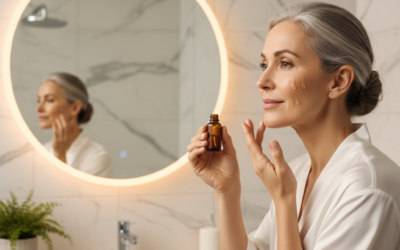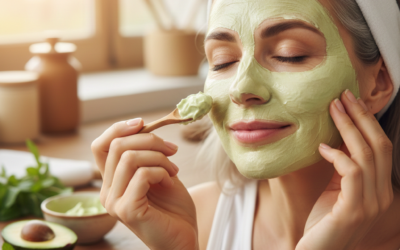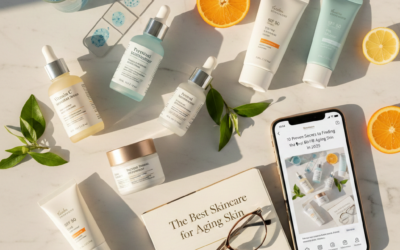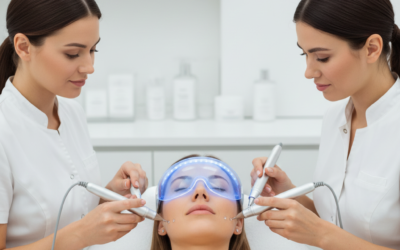Skincare Powerhouse Tips: Why Vitamin C is Essential & Our Top Serum Pick.
Table of Contents
The Ultimate Guide to Finding the Best Moisturizer for Oily Skin (And Why You Need Vitamin C)
For years, a pervasive skincare myth has plagued those with a shiny T-zone: if your skin is oily, you don’t need a moisturizer. This dangerous piece of advice is the root cause of countless skin struggles, from exacerbated breakouts to persistent dehydration. If you have oily, acne-prone, or combination skin, understanding the role of hydration is the single most important step you can take toward balance and clarity.
This comprehensive guide will not only dismantle that myth but also provide a definitive blueprint for identifying the best moisturizer for oily skin in 2025. We will dive deep into crucial non-comedogenic ingredients, explore the revolutionary benefits of adding a Vitamin C Serum to your routine, and map out an optimized, expert-approved regimen that guarantees a balanced, matte, and healthy complexion.
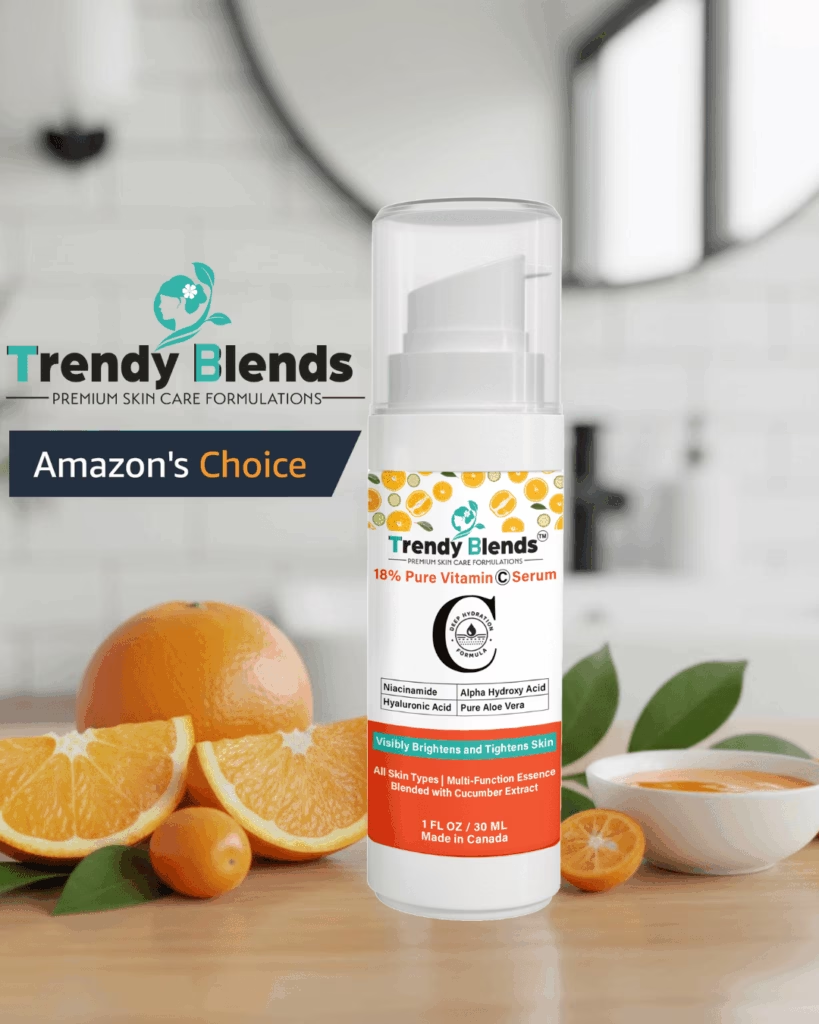
Why settle for less when you can have the best? Our favorite Vitamin C serum isn’t just about brightness—it’s about powerful protection. The Trendy Blends Vitamin C Serum delivers 18% stabilized L-Ascorbic Acid, expertly blended with Aloe Vera to double its photo-protective power, and Hyaluronic Acid for deep hydration. The ultimate anti-aging powerhouse!

Why Oily Skin Needs Moisturizer: Debunking the Myth
The impulse to skip moisturizer when your skin feels perpetually greasy is understandable. Why would you add more moisture to an already saturated surface? The answer lies in the fundamental difference between oil (sebum) and water (hydration).
The Sebum-Hydration Paradox
Oily skin is characterized by an overproduction of sebum, but this doesn’t mean the skin is adequately hydrated. In fact, many people with oily skin suffer from severe dehydration. When skin lacks water, the protective barrier becomes compromised. The body is a remarkably efficient system, and when it senses dehydration, its natural, albeit flawed, solution is to kick the oil glands into overdrive. It attempts to compensate for the lost water by producing more sebum to act as an occlusive barrier, trapping what little moisture remains.
The result? Your skin feels oilier, looks shinier, and your pores become more congested, leading to breakouts—a vicious cycle known as the “sebum-hydration paradox.” The best moisturizer for oily skin breaks this cycle by delivering essential water-based hydration without adding unnecessary oils. By providing adequate hydration, you signal to your skin that it doesn’t need to overcompensate, thus helping to regulate overall oil production.
Protecting the Skin Barrier
The skin barrier (stratum corneum) is like the mortar between the bricks of your skin cells. For oily and acne-prone skin, this barrier is often weakened by harsh cleansers, aggressive scrubs, and drying acne treatments (like benzoyl peroxide or retinoids). A damaged barrier leads to inflammation, sensitivity, and, yes, more oil production.
The right moisturizer repairs and reinforces this barrier. It contains lightweight emollients and occlusives that protect the skin from environmental stressors and water loss while keeping the formula light enough that it won’t trigger congestion. This essential step is the key to achieving long-term skin health and balance.
Decoding the Best Moisturizer for Oily Skin
Finding the perfect formula for your skin type requires vigilance and a keen eye for ingredients. When searching for the best moisturizer for oily skin, the texture and the ingredients list are equally paramount.
Essential Formulations: Gels, Gel-Creams, and Lotions
For oily skin, you must completely avoid rich, thick creams that are heavy in oils and butters, as these are formulated for dry or mature skin. Focus instead on these three ideal formulations:
- Gel Moisturizers: These are water-based and typically oil-free. Their structure is designed to sink into the skin almost instantly, leaving behind no residue, only a weightless feeling of hydration. They are the ultimate choice for extremely oily or hot, humid climates.
- Gel-Creams: This hybrid texture is slightly richer than a pure gel but lighter than a standard cream. They offer a bit more barrier support (often including lightweight ceramides or squalane) but maintain a non-greasy finish. Many dermatologists recommend gel-creams as the best moisturizer for oily skin that also needs anti-aging or barrier-repair benefits.
- Lightweight Lotions: While thicker than gels, modern oil-free lotions are excellent for combination skin or skin that experiences seasonal shifts (becoming oilier in summer, slightly drier in winter). Look for pump bottles and mattifying finishes to ensure optimal performance.
The Non-Comedogenic Mandate
This term is the absolute holy grail for oily and acne-prone skin types. Non-comedogenic means the product has been tested and formulated not to clog pores (comedones). Always look for this label, as it is your first line of defense against breakouts.
When a moisturizer is labeled non-comedogenic, it means the formulators have deliberately avoided highly comedogenic ingredients like lanolin, coconut oil, cocoa butter, and certain high-molecular-weight silicones. Choosing a non-comedogenic formula is crucial because it allows the beneficial active ingredients—which we will discuss next—to perform their job without creating new problems.
Power Ingredients in the Best Moisturizer for Oily Skin
The true effectiveness of any moisturizer lies in its active and supporting ingredients. For oily skin, these components must achieve a delicate balance: providing deep hydration while actively reducing shine and minimizing the appearance of pores.
Niacinamide: The Sebum Regulator
Niacinamide, a form of Vitamin B3, is arguably the most critical ingredient for oily skin, and should be a top priority when seeking the best moisturizer for oily skin. Its benefits are multifaceted:
- Sebum Reduction: Niacinamide at concentrations of 2-5% has been clinically shown to decrease the rate of sebum excretion, leading to less surface oil and a prolonged matte finish throughout the day.
- Pore Minimization: By regulating oil flow, niacinamide also helps tighten and reduce the appearance of enlarged pores.
- Barrier Support: It helps the skin produce natural ceramides, reinforcing the protective barrier and calming inflammation—an essential action for acne-prone individuals.
Hyaluronic Acid: Hydration Without Oil
Hyaluronic Acid (HA) is a humectant, meaning it draws water from the environment into the skin. A single molecule can hold up to 1,000 times its weight in water, delivering intense hydration without any oiliness.
For oily skin, HA is perfect because it addresses the core dehydration issue without contributing to grease. Look for products that feature different molecular weights of HA (e.g., Sodium Hyaluronate), as these penetrate different layers of the skin for comprehensive, lightweight plumping.
Ceramides: Barrier Repair in Lightweight Doses
Ceramides are natural lipids that make up over 50% of the skin’s composition. They are vital for the skin’s barrier function. While heavy creams often use thick lipid blends, the best moisturizer for oily skin will incorporate a balanced ratio of synthetic ceramides (Ceramide NP, AP, EOP) in a lightweight, fast-absorbing vehicle like a gel or fluid lotion. This provides necessary repair and strength without the occlusive weight that can lead to breakouts.
Salicylic Acid (BHA): Pore Refining Power
Salicylic Acid, a Beta Hydroxy Acid (BHA), is oil-soluble, allowing it to penetrate the pore lining and actively dissolve the mixture of dead skin cells and sebum that causes blackheads and whiteheads. While typically found in cleansers and serums, some modern moisturizers designed for severely acne-prone, oily skin include a low concentration of BHA to provide gentle, sustained exfoliation throughout the day. This keeps pores clear and contributes to a smoother skin texture.
Glycerin and Squalane: Lightweight Alternatives
- Glycerin: A classic, simple, and effective humectant that pulls moisture into the skin. It’s highly non-comedogenic and serves as a reliable hydration base in almost every quality, oil-free moisturizer.
- Squalane: Unlike heavier oils, Squalane (the hydrogenated, stable version of Squalene, which occurs naturally in our sebum) is an excellent, lightweight emollient. Derived often from olives or sugarcane, it is exceptionally non-comedogenic and mimics the skin’s natural lipids, offering nourishment without the heavy, greasy feel. It is a brilliant addition to any moisturizer designed for balancing excess oil.
Product Recommendations for the Best Moisturizer for Oily Skin
With the right ingredients in mind, here are tailored product categories and examples of the types of formulas that currently define the market for oily skin care:
Best Overall Gel-Cream for Balance
The CeraVe Oil Control Moisturizing Gel-Cream or the La Roche-Posay Toleriane Double Repair Matte Moisturizer are prime examples of the current gold standard. They are formulated with essential ceramides and high concentrations of niacinamide, delivering robust barrier support and active oil regulation. These products typically absorb instantly, leaving a desirable matte finish that preps the skin beautifully for makeup.
Best Budget-Friendly Option
The Neutrogena Hydro Boost Water Gel (Fragrance-Free version) is a staple for a reason. Its pure hyaluronic acid and glycerin-based gel structure offers immediate, refreshing hydration at an accessible price point. It’s a perfect illustration of how to deliver water-based moisture without any occlusive oils, making it a reliable choice for the vast majority of oily skin types.
Best for Acne-Prone Skin
Look for targeted formulations that combine oil-controlling ingredients with gentle hydrators. The Skinfix Barrier+ Gel Cream, for instance, focuses heavily on strengthening the barrier (preventing the inflammatory response that triggers acne) with peptides and niacinamide, all wrapped up in a fast-absorbing, pore-refining gel base. Products containing a small percentage of Salicylic Acid or Zinc PCA also fall into this category, specifically targeting active blemishes while hydrating.
Best Moisturizer with SPF
Skipping sun protection is the single worst mistake for oily skin. Sun damage exacerbates oil production and darkens post-acne marks (hyperpigmentation). When choosing the best moisturizer for oily skin with SPF, look for mineral-based formulas (Zinc Oxide and Titanium Dioxide) or lightweight chemical filters that are labeled as oil-free and non-comedogenic. A popular type is a mattifying fluid or mineral gel that uses a touch of silica or blotting powders to eliminate shine while providing broad-spectrum UV protection.
Integrating Vitamin C Serum: The Brightening Powerhouse
While your moisturizer handles hydration and oil control, a high-quality Vitamin C Serum is the indispensable treatment step that elevates your oily skin routine from functional to flawless. Far from being too heavy, Vitamin C is uniquely beneficial for oily and acne-prone skin.
Why Vitamin C is a Game-Changer for Oily Skin
Vitamin C (L-Ascorbic Acid or its stable derivatives) offers three powerful benefits perfectly suited for an oily complexion:
- Antioxidant Protection: Oily skin is often exposed to more environmental pollution and UV damage because the excess oil attracts airborne particles. As a potent antioxidant, Vitamin C neutralizes free radicals, reducing oxidative stress and protecting against premature aging and environmental damage.
- Sebum Balancing: Like niacinamide, Vitamin C has been shown to help regulate sebum production. When used consistently, it contributes to less overall greasiness and a clearer skin appearance.
- Brightening and Scar Reduction: Oily skin frequently deals with post-inflammatory hyperpigmentation (PIH)—the stubborn dark marks left after acne heals. Vitamin C is a renowned brightener that inhibits the production of melanin, dramatically fading dark spots and hyperpigmentation, resulting in a more even and radiant skin tone.
Application Timing: Vitamin C Serum Before Moisturizer
The order of application is critical for maximum efficacy. Your Vitamin C Serum must be applied directly to clean, dry skin after cleansing (and toning, if applicable) in the morning. This is because Vitamin C works synergistically with your sunscreen to boost protection against the sun’s rays.
Wait about one minute for the serum to fully absorb before applying your chosen lightweight moisturizer (preferably one with SPF). By placing the serum first, you ensure its potent actives can penetrate the skin without being blocked by the larger molecules in your moisturizer.
Choosing the Right Vitamin C Formula
For oily skin, formulation stability and vehicle are everything.
- Vehicle: Always opt for a light, water-based, or oil-free serum. Heavy oil-based Vitamin C treatments are almost guaranteed to feel greasy and clog pores.
- Derivatives: If L-Ascorbic Acid (LAA) is too potent or irritating, look for stable derivatives that are gentler on oily, sensitive skin. Excellent alternatives include Sodium Ascorbyl Phosphate (SAP), which also has antibacterial properties, or Tetrahexyldecyl Ascorbate (THDA), a stable, oil-soluble form that is exceptionally gentle and effective.
Building the Optimized Oily Skin Skincare Routine
Armed with your understanding of the best moisturizer for oily skin and the benefits of Vitamin C Serum, here is how to layer your products for optimal results, both morning and night.
The Morning Routine (Focus: Protect & Control)
The goal of your morning regimen is to control oil production, neutralize environmental aggressors, and protect the skin from UV damage.
| Step | Product Type | Key Action & Ingredients |
|---|---|---|
| 1. Cleanse | Gentle Foaming Cleanser | Remove overnight sebum and impurities without stripping the barrier. Look for Niacinamide or gentle surfactants. |
| 2. Treat | Vitamin C Serum | Apply a few drops to a dry face. Provides antioxidant protection, brightens, and begins sebum regulation. |
| 3. Hydrate & Protect | Best Moisturizer for Oily Skin with SPF 30+ | Use a lightweight, non-comedogenic fluid, gel, or lotion that includes broad-spectrum sun protection. This is the single most important step for protecting and balancing skin. |
The Evening Routine (Focus: Treat & Repair)
The evening regimen is dedicated to deep cleansing, active treatment of concerns (acne, texture), and barrier repair while you sleep.
| Step | Product Type | Key Action & Ingredients |
|---|---|---|
| 1. Double Cleanse (Optional) | Micellar Water or Cleansing Oil (Non-Comedogenic) | Essential for removing heavy makeup or water-resistant SPF. Follow with a gentle foaming cleanser. |
| 2. Treat/Active | Acne/Retinoid Treatment | Apply targeted treatments (Salicylic Acid, Benzoyl Peroxide, or Retinol/Retinal) to address breakouts and texture concerns. Allow this to dry completely. |
| 3. Moisturize | Best Moisturizer for Oily Skin (Repair Focus) | Use a simple, non-SPF gel-cream or lightweight lotion. Look for Ceramides, Glycerin, and Hyaluronic Acid to reinforce the barrier and counteract any dryness from your actives. |
Skincare Spotlight: The Hottest Trends and Why Vitamin C is Essential
In the fast-moving world of skincare, trends come and go, but some ingredients prove their staying power through consistent, science-backed results. Vitamin C (Ascorbic Acid) is undoubtedly one of those superstars, prized by dermatologists and enthusiasts alike for its comprehensive benefits.
The Power of Vitamin C
Vitamin C is a potent antioxidant that combats free radical damage caused by UV exposure and pollution. Regular use helps to brighten the skin tone, fade hyperpigmentation and dark spots, and stimulate collagen production, leading to firmer, smoother, and more youthful-looking skin. Incorporating a high-quality serum is the most effective way to deliver this ingredient deep into the epidermis.
The Recommendation: Trendy Blends Vitamin C Serum
When looking for a serum that delivers maximum impact, the Trendy Blends Vitamin C Serum stands out as a highly effective choice currently trending in the beauty community.
This serum utilizes a potent 20% concentration of stabilized L-Ascorbic Acid, ensuring efficacy without rapid degradation. It is expertly blended with key co-factors, including:
- Aloe Vera: This botanical antioxidant works synergistically with Vitamin C to double its photo-protective benefits and stabilize the formula for a longer shelf life.
- Hyaluronic Acid: Included for deep, lasting hydration, this helps to plump the skin and reduce the appearance of fine lines, making the serum suitable even for drier skin types.
The serum is praised for its lightweight, fast-absorbing texture, making it ideal for layering under sunscreen and makeup in the morning routine. Users report visible improvements in brightness and texture within just a few weeks of consistent use.
Essential Lifestyle Tips for Managing Oily Skin
No moisturizer, no matter how effective, works in isolation. Oily skin management also relies heavily on daily habits:
- Avoid Over-Washing: Washing your face more than twice a day (morning and night) and after sweating will strip your skin barrier and trigger the rebound oil production we want to avoid. Use gentle blotting papers, not powder, to manage mid-day shine.
- Hands Off Your Face: Touching your face transfers dirt, oil, and bacteria from your hands directly to your pores. This is the fastest way to generate a new crop of blemishes.
- Clean Pillowcases: Change your pillowcase at least twice a week. Your pillowcase absorbs overnight oil, dead skin cells, and product residue, which can transfer back to your skin.
- Diet and Stress: While skincare products are topical, diet (especially high glycemic index foods) and stress can significantly influence sebum production. Managing these internal factors is a complementary action to your carefully curated product routine.
Conclusion: The Path to Balanced Skin
The hunt for the best moisturizer for oily skin is a journey toward balance, not dryness. By rejecting the myth that oily skin must be stripped of moisture, you empower your skin to regulate itself. The secret lies in lightweight, non-comedogenic formulations loaded with regulatory ingredients like Niacinamide and hydrating humectants like Hyaluronic Acid.
When you seamlessly integrate a Vitamin C Serum into your morning routine, you add a layer of environmental defense and powerful brightening that addresses the textural and hyperpigmentation issues common with oily complexions. Commit to this optimized, multi-step regimen—focusing on hydration, oil control, and protection—and watch as your shiny, unpredictable skin transforms into a balanced, clear, and radiant canvas.



